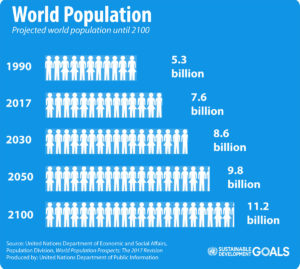Mapping global population
More than a billion people were added to the world’s population over the past 12 years, bringing the total population to 7.6 billion as of mid-2017, according to a new UN report.
The world population is currently growing by 1.10 percent every year, yielding an additional 83 million people annually.
About 60 percent of the world’s people live in Asia, 17 per cent in Africa, ten percent in Europe, nine percent in Latin America and the Caribbean, and the remaining 6 percent in Northern America and Oceania.
 China with 1.4 billion and India with 1.3 billion remain the two most populous countries of the world, comprising 19 and 18 percent of the global total respectively.
China with 1.4 billion and India with 1.3 billion remain the two most populous countries of the world, comprising 19 and 18 percent of the global total respectively.
The report by the UN’s Department of Economic and Social Affairs (DESA) found that international migration remains an important distribution pattern of the global population.
The UN’s 2030 Agenda for Sustainable Development recognises that international migration can be a positive force for economic and social development by balancing labour between areas of origin and destination, and increasing the global productivity of labour.
The world’s population of 7.6 billion will balloon to 9.8 billion by 2050 and India will overtake China as the most populous country in just seven years, the report has said.
It forecasts that from now to 2050, half of the world’s population growth will be concentrated in just nine countries: India, Nigeria, Congo, Pakistan, Ethiopia, Tanzania, the US, Uganda and Indonesia – in the order of their expected magnitude of growth.
At this rate, the world’s population will reach 8.6 billion in 2030, 9.8 billion in 2050 and 11.2 billion in 2100.
The report titled ‘The World Population Prospects: The 2017 Revision’ said that by 2050, Nigeria will overtake the US to become the third most populous country.
“With roughly 83 million people being added to the world’s population every year, the upward trend in population size is expected to continue, even assuming that fertility levels will continue to decline,” the report said.
“The population in Africa is notable for its rapid rate of growth, and it is anticipated that over half of global population growth between now and 2050 will take place in that region,” it said.
John Wilmoth, the UN’s Director of the Population Division, said that Europe’s population would decline.
“At the other extreme, it is expected that the population of Europe will, in fact, decline somewhat in the coming decades,” he said.
The projections also forecast that China, which currently has 1.4 billion inhabitants, will be replaced as the world’s most populous country around 2024 by India with a current population of 1.3 billion.
Nigeria, currently the world’s seventh largest country, is growing the most rapidly, and the populations in 26 African countries are likely to “at least double” by 2050.
The report also said fertility has been declining in nearly all regions in recent years.
Between 2010 and 2015, “the world’s women had 2.5 births per woman … but this number varies widely around the world,” the report said.
“Europe has the lowest fertility level, estimated at 1.6 births per woman in the most recent period, while Africa has the highest fertility, with around 4.7 births per woman,” it said.
As well as slowing population growth, low fertility levels will lead to an older population, the report noted.
The number of persons aged 60 or above is expected to more than double by 2050 and more than triple by 2100.
Laurie Nowell
AMES Australia Senior Journalist












